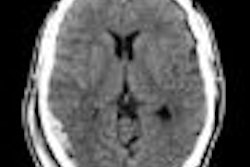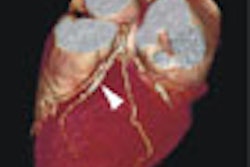VIENNA - Three studies presented Friday at the 2008 European Congress of Radiology (ECR) reinforced a correlation between gadolinium MRI contrast and renal patients who subsequently developed nephrogenic systemic fibrosis (NSF). But significant questions still remain about the etiology of this mysterious disease.
The cause of NSF, a debilitating and occasionally fatal disease, remains unclear. NSF can include fibrosis of the bone, dura, kidneys, lungs, muscle, myocardium, pericardium, pleura, skeletal muscle, and testes. Despite its notoriety, the disease is rare, and this was reflected in the uniformly low number of patient populations of the presented studies.
Emory study
Only 14 patients with NSF were identified in a rigorous search of medical records of dialysis patients receiving treatment at Emory University Hospital in Atlanta from March 2003 through February 2007. The objective of this search was to identify incidence, relationship, and co-factors of NSF development, according to Thomas Lauenstein, Ph.D., an associate professor of research.
The retrospective study cross-referenced four databases (pathology, MRI, dialysis, and medical records) to identify patients. Medical records were searched for a history of deep venous thrombosis, surgery, or infections. Laboratory data and concurrent medication were evaluated. MRI records were evaluated with respect to the number of gadolinium doses, dose size, time interval between doses, and total lifetime dose.
All patients had undergone contrast-enhanced MRI prior to NSF diagnosis. Eight of the patients did not have their procedures performed at Emory, and because their records did not contain some or all of the data being evaluated, they were excluded from the study.
However, Lauenstein reported that there was no correlation of any kind with respect to the frequency or dose of gadolinium. The nine patients were evaluated against a control group of dialysis patients who were cross-matched for age, gender, medical history, and comparable dose and timing.
Emory University Hospital only used one gadolinium compound during the course of the study (Omniscan [gadodiamide], GE Healthcare, Chalfont St. Giles, U.K.).
NSF occurred after gadodiamide exposure in approximately 3% of all patients receiving dialysis during the four-year study, Lauenstein reported. "This was the strongest correlation we identified."
The evaluation of patient medical histories revealed two cases of deep venous thrombosis, two incidents of acute peritonitis, and one case of mesenteric ischemia.
"Since March 2007, we have been using more stable chelates, and there have been no new NSF cases in renal patients reported," Lauenstein said. "It is possible that the use of cyclic chelates may be the clinical solution, but this is only my speculation."
University of Vienna study
No correlation between intravenously delivered gadolinium-based contrast agents and patients with chronic renal failure who had NSF was found in a similar retrospective study performed at Vienna General Hospital at the Medical University of Vienna. Dr. Gertraud Heinz-Peer reported that out of 195 cases of patients who had MRI procedures performed with a documented contrast agent only six had an NSF diagnosis.
A total of 552 radiological records of patients who received dialysis over a 10-year period between 1997 and 2007 were reviewed. Number of injections, type, cumulative dose, and possible co-factors were evaluated. There were 367 patients who had undergone contrast-enhanced MRI, but the records of 172 of these patients did not contain all the data being measured and were therefore excluded.
Seven different contrast agents were utilized in the 10-year period. The most commonly used contrast agents were Omniscan (GE Healthcare) with 153 patients, Magnevist (Bayer Schering Pharma, Berlin) with 64 patients, and Dotarem (Guerbet, Roissy, France) for 56 patients.
The body parts imaged were abdomen/pelvis (135 patients), MR angiography (102 patients), and brain (88 patients). No significant difference regarding cumulative dose and type of contrast agent was found between NSF-affected and nonaffected patients, although there was a slight tendency toward gadodiamide, Heinz-Peer reported.
"A history of thrombosis and recent surgery proved to be significant risk co-factors for development of NSF," Heinz-Peer said. "These patients are fragile and more susceptible to disease."
A total of 3.1% of the patients in the study developed NSF. Had the patients whose files did not contain comprehensive data about dose and contrast agent used been included, the percentage with NSF would have dropped by almost 50%, to 1.6%, Heinz-Peer reported.
The FINEST study
In another study presented, the records of 308 patients with renal insufficiency who had undergone an MRI examination with or without gadolinium in nine French nephrology departments in a 12-month period were evaluated. Data for the FINEST (Fibrose Néphrogénique Systémique) study included sex, age, renal function, type of gadolinium administered, and cutaneous disorders.
Nearly 59% of the patients were men and 51.2% were women, all averaging 69 years of age. Some 60% received dialysis and 53.6% had stage 5 (RI) renal disease, with 76.3% receiving gadolinium.
Dr. Vincent Launay-Vacher of Pitié-Salpêtrière Hospital in Paris, who presented the study, stated that no cases of NSF were reported in this cohort. The audience was quite skeptical of this, and Launay-Vacher was told by one of the presenters that his study weakness was the fact that none of the investigators had actually examined the patients as they had the records. It was noted that some physicians did overlook nonsevere cases of NSF and that different results may have been found if this had been done.
By Cynthia Keen
AuntMinnie.com contributing writer
March 7, 2008
Related Reading
Study offers more evidence that multiple factors up NSF risk, January 24, 2008
'Uniquely higher' relaxivity rates give gadobenate an edge, January 23, 2008
Studies outline techniques for ramping up MR in renal artery imaging, January 10, 2008
Gadolinium release linked to overall stability of contrast agent, may trigger NSF, January 9, 2008
Copyright © 2008 AuntMinnie.com

















